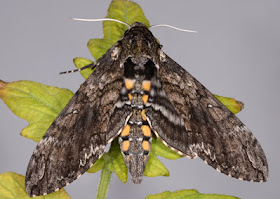 |
| Snowberry clearwing moth - REK |
These hummingbird moths are a common sight around a flower garden this time of year. People love to see them hover, slurping up nectar through their long proboscis as they flit between blossoms. We have two hummingbird moth (HM) species, snowberry clearwings (Hemaris diffinis) and hummingbird clearwings (Hemaris thysbe). Their ranges overlap in Missouri as seen here.
 |
| Clearwing at rest - REK |
We heard from several friends the last week, concerned that when they are finding large green hornworm caterpillars that these are HM babies eating their tomato plants. These moths are not the same species although they are relatives. There are many web sites that add to the confusion by calling hawk moth caterpillars by an alternate common name of hummingbird moth, demonstrating the importance of scientific names.
 |
| H. diffinis on tubular flower - J. Motto |
Our friendly HM feed in daylight hours although they may stay out for a late supper if they find a great menu. They are especially adapted to sip from tubular flowers, just like a hummingbird. Their larvae feed on honeysuckle family members - buckbrush, snowberry, horse gentian, Lonicera spp and dogbane including Amsonia (blue star). H. thysbe cats also eat viburnum, hawthorns, cherry and plum.
 | |
| Snowberry clearwing hornworm caterpillar |
Their larvae are equipped with a horn on the end, thus a"hornworm." This is another cause of confusion as the hated tomato and tobacco hornworms that decimate tomato plants are similar although much larger.
 |
| Tobacco hornworm |
Tobacco and tomato? How can that be a common food plant between these hawkmoth larvae? Science Daily sheds some insight.
"The Solanaceae is a family of flowering plants, many of which are edible, while others are considered poisonous. The family is informally known as the nightshade or potato family. The family includes the Datura or Jimson weed, eggplant, mandrake, deadly nightshade or belladonna, capsicum (paprika, chile pepper), potato, tobacco, tomato, and petunia.
The Solanaceae are known for possessing a diverse range of alkaloidal glucosides, or simply alkaloids. As far as humans are concerned, these alkaloids can be desirable, toxic, or both, though they presumably evolved because they reduced the tendency of animals to eat the plants."
 |
| Manduca sexta - Lyle Buss UFL |
The tobacco and tomato hornworms hawkmoths are in the genus Manducae. Unfortunately they are called hummingbird moths in some references. They can hover like a hummingbird but they are mainly crepuscular, flying primarily at sunset and sunrise.
A frequent question a naturalist hears are "what good are fill in the blank?" Even mosquito larvae feed a number of aquatic species. In this case, you can take comfort in this long answer from the Featured creatures of UFL.edu."Tobacco hornworms have several natural enemies, including vertebrate species that feed on caterpillars, such as birds and small mammals, and insects like lacewing and lady beetle larvae that consume the eggs and early instar larvae. Wasps are a common predator of hornworms. Paper wasps and other insects that provision prey for their young will take hornworms from the host plant, paralyze them, and place them into the nest cells containing the wasp’s eggs as a future food source.
Parasitoid wasps, like Cotesia congregata, use hornworms as a food source for their developing young. These wasps deposit their eggs inside the hornworm’s body and the larval wasps develop within the caterpillar, feeding on it as they progress through their life cycle. When pupation takes place, the immature wasps spin small, white, silken cocoons that protrude from the body of the still-living caterpillar. The cocoon-covered hornworms are a sight of great interest in the garden, and many fear that the parasitized caterpillars will have a negative impact on their garden. In fact, the opposite is true because the hornworm will eventually die and several adult wasps will emerge, mate, and seek out additional hornworm hosts for their eggs."
Revenge of a parasitoid wasp - REK So fear not, defend your tomato plants with a clear conscious.





























